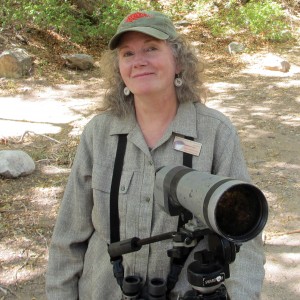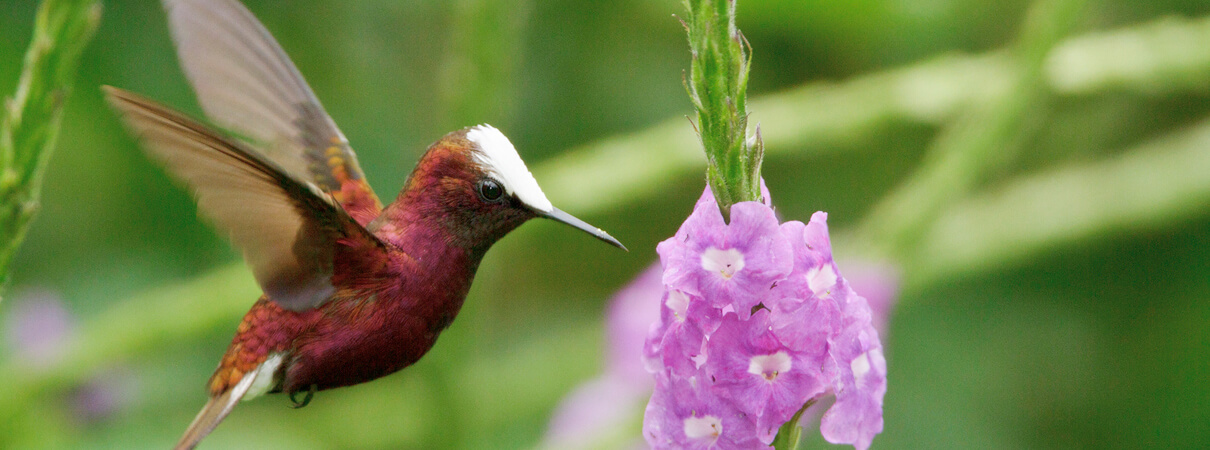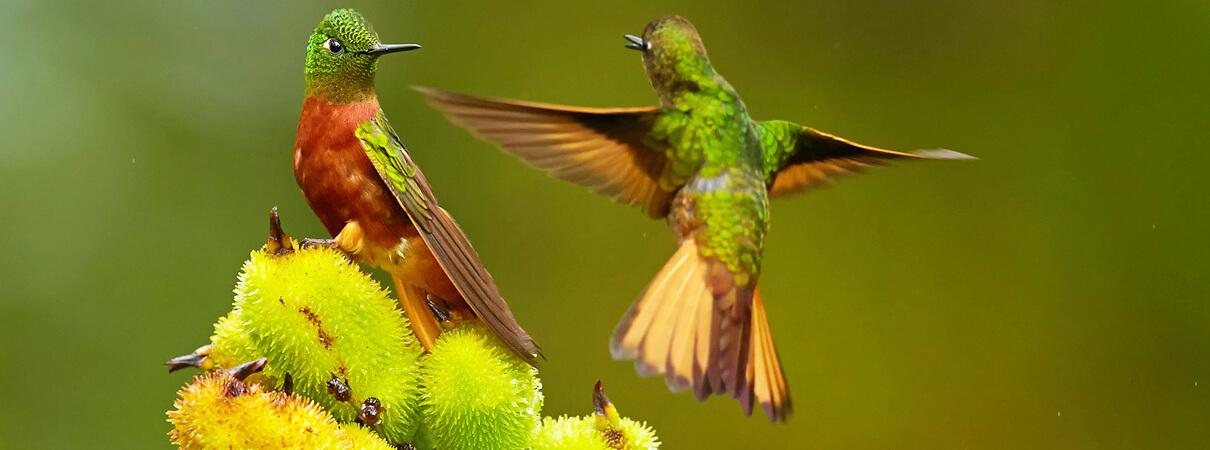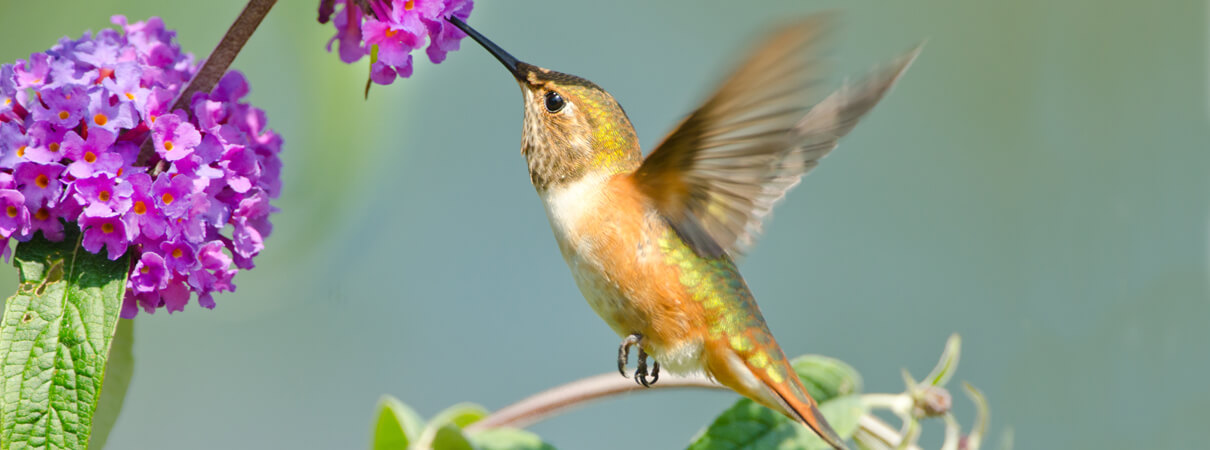Hummingbirds 101: An Expert Explains the Dynamos of the Bird World
When it comes to hummingbirds, Sheri L. Williamson wasn't always fascinated by the birds she calls “prismatic pugilists.” But when she and her husband moved to The Nature Conservancy's Ramsay Canyon Preserve in Arizona, Williamson began to pay serious attention to them. Soon “I pretty much had hummingbird blood pumping through my veins,” she says. “They have their way of getting those tiny little claws into you.”
 The author of A Field Guide to Hummingbirds of North America (Peterson Field Guide Series), Williamson is also the founder and co-director of the Southeastern Arizona Bird Observatory, and writes and speaks frequently about birds and conservation.
The author of A Field Guide to Hummingbirds of North America (Peterson Field Guide Series), Williamson is also the founder and co-director of the Southeastern Arizona Bird Observatory, and writes and speaks frequently about birds and conservation.
Jennifer Howard: What intrigues you about hummingbirds?
Sheri Williamson: Hummingbirds do just have a way of obsessing you. They're so fascinating, they're so diverse, and there's still so much we don't know about them. The Sword-billed Hummingbird in the Andes—nobody's ever seen their nest. Even some of our more familiar species are still yielding secrets.
JH: Do you have a favorite species?
SW: My favorite species is more or less the one that's in my binoculars at the moment. My favorite almost has to be the Black-chinned Hummingbird. It's a pretty ordinary hummingbird in most respects. But I spent so much time banding them, getting to know their personal history, they're almost like family.

Black-chinned Hummingbird, sumikophoto/shutterstock
JH: Hummingbirds are so tiny. What can you tell us about their strength—and their distinctive way of flying?
SW: They're incredibly strong. They can lift a much greater proportion of their weight than eagles can. A hummingbird can bulk up from 3 grams to 6 grams and still be able to fly.
Their wings are much flatter than those of other birds. They don't cup the air. They're using the wing in a figure-eight motion. So much of the way they fly, and the way their nervous system interacts with their muscles, is more like insects. They're phenomenal athletes.
JH: How smart are they?
SW: They're among the brainiest of the birds. They have amazing memories. They can remember not only which plants have nectar but how often it's replenished and which flowers they've just visited. Absolutely they remember your backyard. And they may even remember you. If the feeder is empty, they come looking for you.
JH: Do they sing?
SW: Though few of our familiar North American hummingbirds are singers, singing is more the norm than the exception. In fact, many hummingbirds are very creative singers, and can incorporate bits of other birds' songs into their own. Having a variety of songs is a signal of success. Females don't want a guy in a garage band who can only play three chords of “Wild Thing.”

Snowcap, Glenn Bartley
JH: What do hummingbirds eat besides nectar?
SW: When the females are feeding their young, they have to eat more insects, because you don't build strong bones and beaks on nectar or sugar water. They are such high-energy birds, though, that they really do need that sugar. Spider silk is a very important part of a hummingbird's nest-building toolkit, and hummingbirds will eat trapped insects and baby spiders while they're taking spider web. Researchers have found that spiders are naturally high in an amino acid called taurine, a very important component for brain and nervous-system growth. It's like brain food for hummingbirds.
JH: We've heard reports that more hummingbirds are overwintering in the U.S. now. Is that true?
SW: From the Gulf States up the Eastern Seaboard, more and more northern hummingbirds are successfully overwintering. This flexibility may help them adapt as climate change alters their traditional wintering habitats.
JH: Why are there so many species west of the Mississippi?
SW: Hummingbirds really are mountain birds. Lots of mountains in the West! Those mountains provide a tremendous diversity of habitat for hummingbirds. (Editor's note: Some western U.S. hummingbirds include Allen's, Anna's, Costa's, and Violet-crowned.)
JH: Why are they so territorial at feeders?
SW: They are savage, savage creatures. When you think about it, a hummingbird feeder is a really unnatural situation. They can't quite get their heads around that. Their instincts tell them that nectar is a precious and finite resource.

Chestnut-breasted Coronets, Martin Mecnarowski/Shutterstock
JH: Habitat loss is a major threat to hummingbirds' survival. What other challenges do they face?
SW: In the temperate zone, weather is a major challenge, but hummingbirds are vulnerable to predation too. Some get caught by larger birds, even big flycatchers, or tangled in the webs of large spiders, or snatched off feeders by large mantids. Almost anything that will eat a large insect can eat a hummingbird. And then there's climate change: The colder colds, the hotter hots, the more ferocious storms are threats to all kinds of birds, not just hummingbirds.
JH: Why do we only have hummingbirds in the Americas?
SW: That is the $64 million question. It's very, very rare, but there are hummingbird fossils. They're not from the New World. They're from Europe. Thirty million years ago there were hummingbirds in Europe, and they were almost identical to our North American hummingbirds.
JH: What do we know about hummingbird migration?
SW: They're facing a lot of pretty daunting challenges when they migrate. But some of these birds put on enough fat that they could travel more than 1,100 miles across the Yucatan, across the Gulf of Mexico. These guys are much better oriented than we give them credit for. We consistently underestimate the abilities of hummingbirds. They have internal compasses and they have internal calendars.

Female Rufous Hummingbird, Birdiegal/Shutterstock
A little female Rufous Hummingbird was captured and banded one winter in Tallahassee, Fla. The next summer she was recaptured 3,500 miles away on the shore of Prince William Sound in Alaska. That girl had at least 7,000 frequent-flyer miles in her account, and she wasn't even a year old.
We're reluctant to believe that something that small and seemingly delicate can undertake a challenge that would be daunting to us if we were that size. But they do, and they do a great job.
Watch this video to learn more about how American Bird Conservancy protects hummingbirds across the Americas. Or learn more about Williamson on her website.)
Editor's note: This article first appeared in the summer 2016 edition of Bird Conservation magazine.
 Jennifer Howard is Director of Public Relations at American Bird Conservancy. She was a writer and reporter with The Chronicle of Higher Education for 10 years and before that was a contributing editor and columnist with The Washington Post. She writes nonfiction for The Times Literary Supplement and the Boston Review and her fiction work has been published by Virginia Quarterly Review and others. Follow Jen on Twitter at @JenHoward.
Jennifer Howard is Director of Public Relations at American Bird Conservancy. She was a writer and reporter with The Chronicle of Higher Education for 10 years and before that was a contributing editor and columnist with The Washington Post. She writes nonfiction for The Times Literary Supplement and the Boston Review and her fiction work has been published by Virginia Quarterly Review and others. Follow Jen on Twitter at @JenHoward.


















































